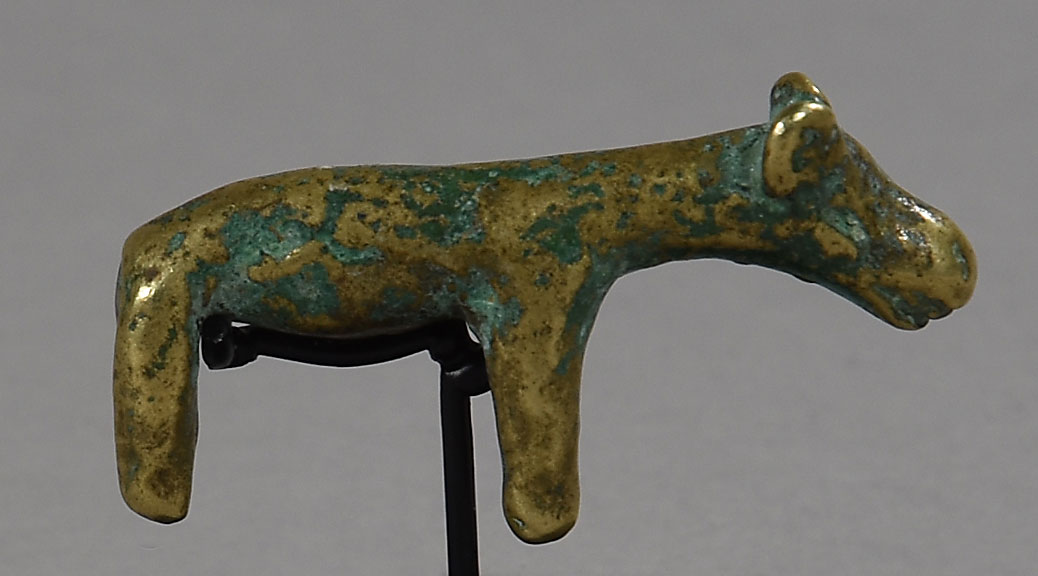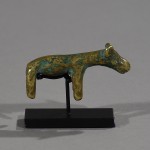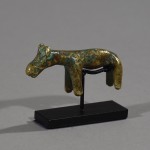NAK 1015-15 SOLD
Kotoko Warrior/Horseman (Putchu Guinadji), Chad (Cameroon)
Copper/brass/bronze alloy.
Dimensions: H: 3 cm (1,2”), L: 6 cm (2,4”), W: 1,6 cm (0,6”), Weight 50 gram
This Putchu Guinadji equestrian warrior was used as a talisman against madness and witchcraft by the Kotoko people in Cameroon and Chad.
These cast equestrian figures, excavated in Chad, was cast by the Kotoko, descendants of the Sao (who disappeared in the 16th C.). Little is known of the Kotoko civilization, but the Sao was one of the oldest metal-working cultures in West Africa. Kotoko bronze equestrian figurines are modeled with elegant curves, tapering legs, and highly detailed tack, bridles, and saddles. Small and therefore portable, these figurines were personal objects used as protective amulets around the neck or sewn in a small leather pouch and worn close to the body.to be carried for their therapeutic value.
The Kotoko were inheritors of an ancient people known as the Sao who lived in the southern Lake Chad region as early as the second century B.C. Under external pressures the Sao through time moved into northwest present day Cameroon settling in the hilly region where the present day Kotoko claim them as ancestors. Taking up traditions of other immigrant peoples into their areas the Sao buried their dead in large urns, a practice seen across a wide region stretching from the Niger River through Chad, Niger, Nigeria and to the northern regions of Cameroon. Small mounted figures cast in bronze were made as funeral offerings or memorials. Mounted warriors rode horses, sometimes camels and other unknown and imaginative animals. Often there were two riders mounted on a single animal. The horses often had elaborate trappings of harness and saddle and the riders were portrayed wearing detailed headdresses, costumes and jewelry. This is a small scale and plain example of this very old tradition.
Numerous scientific papers and books are written about this mysterious people. Figures like this dating back to the 2nd century. What is interesting for science is that in the area fossilized dinosaurs are found which has created myths and theories which today occupy many experts and scientists.
Why the figures often depicted horses is because in the petrified dinosaur they did not find the lower back and legs, and thus imagined that it must be ‘horse’ of some kind. Theories are also going in against ‘dwarf elephants’.
Bronze Kotoko artifacts are quite rare, and especially praised by collectors and connoisseurs alike. The Sao people was an ancient indigenous group of Bantu speakers who trace back 7,000 years to when this sub-Sahara region was not a desert but had ample water supply, and Lake Chad was sixty feet above its current level.
Age: Est. after the 15th Century.
Provenance: Private Belgian collection acquired through a Brussels gallery.
Recommended Reading:
Peroni, Pierluigi – Kotoko Warriors 2011.
Lebeuf, J.P. and A. Masson Detourbet, La civilisation du Tchad. 1950.
Lebeuf, J.P, Archeologie tchadienne: les Sao du Cameroun et du Tchad. 1962.
Jansen, G. and J.-G. Gauthier, Ancient Art of the Northern Cameroon: Sao and Fali. 1973.
J.-P. and A. Lebeuf, Les Arts Anciennes de l’Ouest Africain. 1977.




